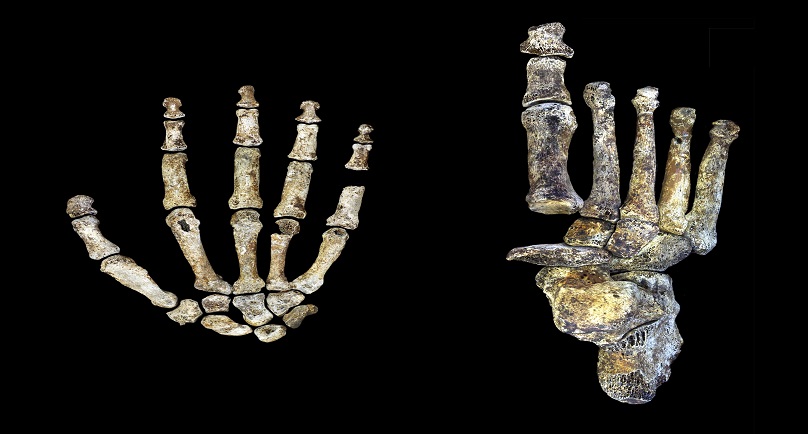Image: Fossils of the hand and foot of the ancient human ancestor called Homo naledi, discovered in a cave in South Africa, are shown in this handout photo provided byWits University in Johannesburg, South Africa, October 6, 2015. REUTERS/Peter Schmid and William Harcourt-Smith/Wits University/Handout via Reuters
By Will Dunham
WASHINGTON (Reuters) – Homo naledi, the ancient human ancestor whose fossils have been retrieved from a South African cave, may have been handy with tools and walked much like a person, according to scientists who examined its well-preserved foot and hand bones.
Its foot and hand anatomy shared many characteristics with our species but possessed some primitive traits useful for tree climbing, the researchers said on Tuesday.
Scientists last month announced the discovery of this previously unknown species in the human linage in a cave northwest of Johannesburg. The new research offers fresh insight into a creature that is providing valuable clues about human evolution.
Paleoanthropologist Tracy Kivell of Britain’s University of Kent said it boasted a hand “specialized for fine, powerful manipulation.” Its wrist bones and thumb showed features shared with modern people and Neanderthals and indicated powerful grasping and the ability to employ stone tools.
Its strongly curved fingers, rather than the straight ones of people and Neanderthals, suggested it also regularly used its hands for climbing.
Its foot was largely like ours, particularly in the ankle joint anatomy, the presence of a non-grasping big toe and the proportions of the region from the ankle to toes.
Dartmouth College anthropologist Jeremy DeSilva said it was well-adapted for long distance walking and perhaps running. “The legs are long, the knees are like ours, the feet are human-like. Homo naledi walked a lot like us,” DeSilva said.
It possessed some primitive foot features: a flatter arch, curved toes and a heel less robust than ours.
Paleoanthropologist William Harcourt-Smith of Lehman College CUNY and New York’s American Museum of Natural History said Homo naledi would have been more proficient than modern humans in the trees based on its curved finger and toe bones.
“Our science has known for decades that upright walking, bipedalism, preceded brain enlargement over the course of human evolution. But never before has it been so obvious. Homo naledi possessed a strikingly modern human-like foot, even though its brain was only about one-third the size of our brains today,” DeSilva said.
Similarly, its tool-friendly hand anatomy in combination with its small brain “causes us to perhaps rethink the cognitive requirements for tool use,” Kivell said.
The scientists who discovered it call Homo naledi one of the most primitive members of the genus Homo, which includes modern humans. The fossils’ age has not been determined.
The research appears in the journal Nature Communications.
(Reporting by Will Dunham; Editing by Sandra Maler)
Copyright 2015 Thomson Reuters. Click for Restrictions.


